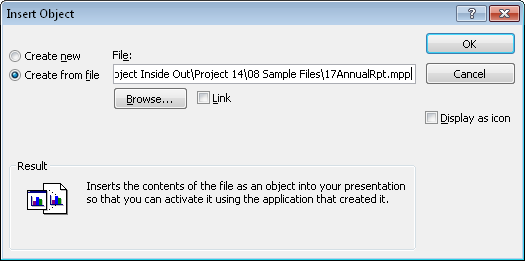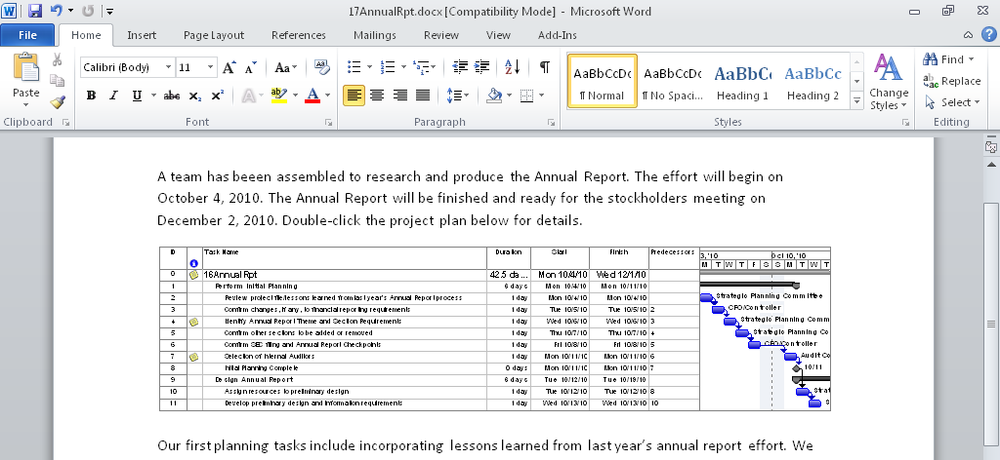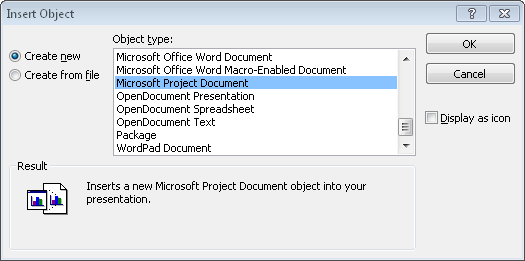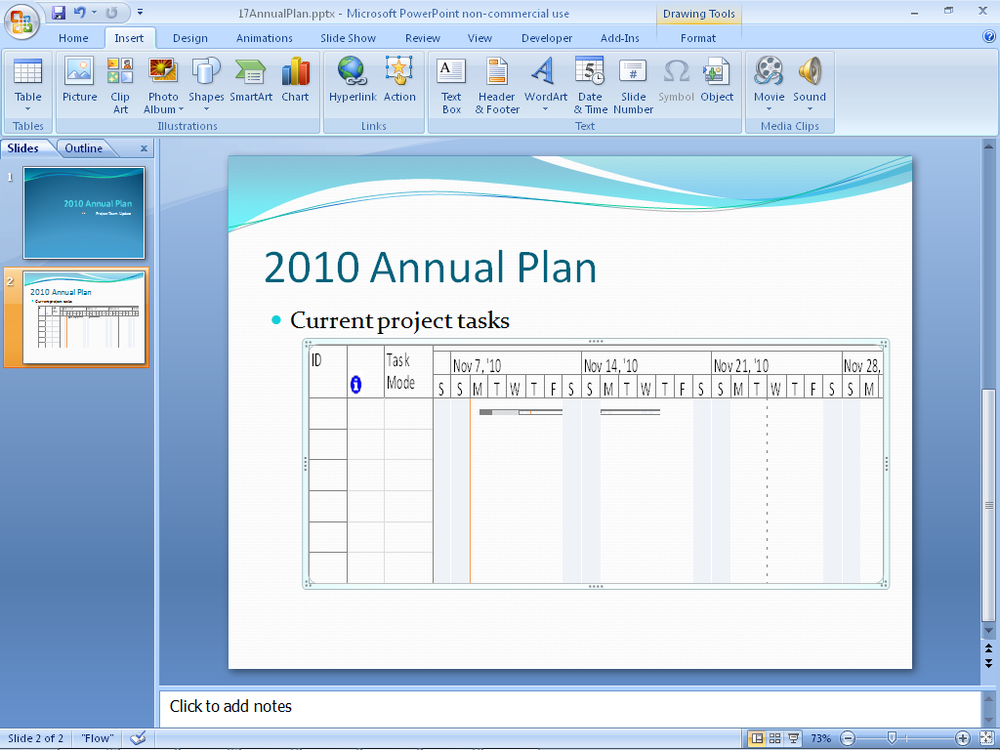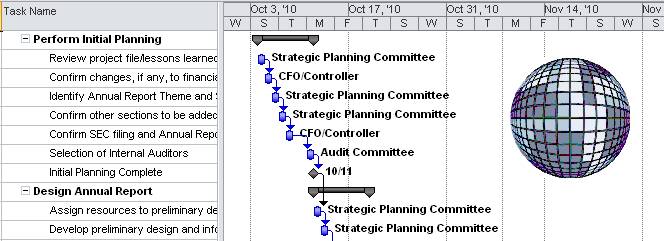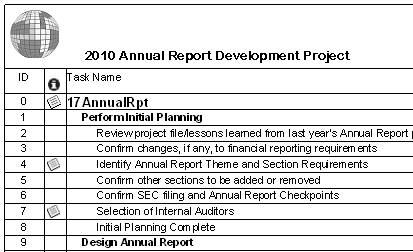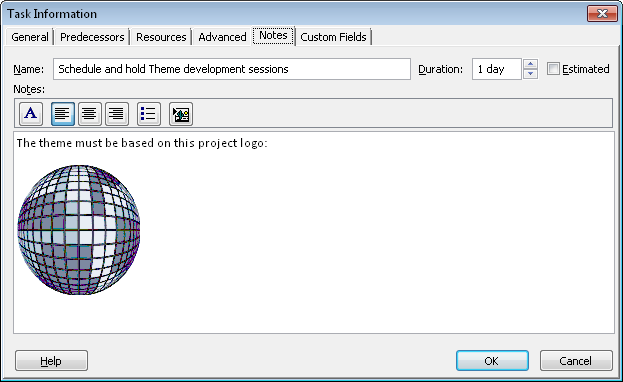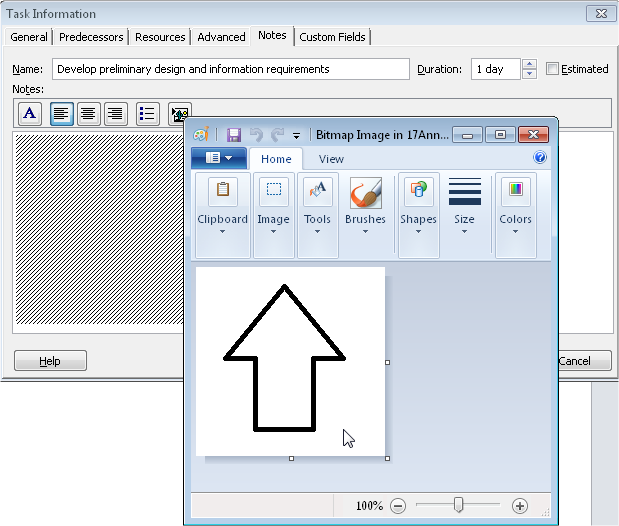You can insert information from another application into Project 2010 and have that information behave as though that application is resident in Project 2010.
Likewise, you can insert a piece or all of a project plan into another application, such as a PowerPoint presentation or an Excel workbook, and work with that project plan as though you’re working in Project 2010.
Whichever the direction, this method of exchanging information is done by embedding an object, which allows for great power and flexibility across different applications.
An object is a set of data that gets its format and behavior from another application. When you embed an object, you’re basically inserting an entire file, with all of its source application’s capabilities, into the destination application.
For example, suppose that in Project 2010 you embed a bit of art originally created in a graphics program. The art object appears in Project 2010 as though you created it there. If you double-click the object, the graphics application in which it was created is launched, and you can change the illustration on the spot, save the changes, and close the application. The changes you make are reflected instantly in the art showing in Project 2010.
In order for embedding to work properly, both the source and destination applications must be installed on the same computer or have ready network access to both applications. Also, because embedding inserts an entire file within another file, it uses a large amount of memory while the project is open and makes the destination file much larger.
Note
Embedding objects between different applications is made possible by OLE technology. Any application that employs the OLE standard can embed and link information from another application that also employs that standard.
You can embed a Project 2010 file in another application—for example, Word or PowerPoint. When you double-click the object in the destination application, Project 2010 is launched on the spot, and you can switch views and manipulate data.
To embed an existing Project 2010 file in another application, follow these steps:
Open the destination application and the file in which you want to embed the Project 2010 file.
Select the location where you want the Project 2010 object to be embedded.
Select the command to insert an object.
If you’re embedding the file in an Office application, on the Insert tab, in the Text group, click Object.
If the destination application does not have an Insert Object command, it probably does not support embedding. Look in the application’s online Help or other documentation to see whether the command is called something else.
In the dialog box, click the Create From File option or tab.
Click the Browse button.
The Browse window appears. Browse through your computer’s filing system (and onto your network if applicable) to find the drive and folder in which the project file is located.
Double-click the file.
Its path and name are entered in the File Name box in the dialog box. (See Figure 17-6.)
If you want the embedded object to be linked to the source, select the Link check box.
If you link the object, any changes in the original update the embedded object. Likewise, any changes made in the embedded object are reflected in the original.
If you don’t link the object, you’re essentially making a copy of the original object, which becomes a separate entity from the original. You can change the embedded version without affecting information in the original.
If you want to display the embedded project as an icon in the destination application, rather than show it in the Gantt Chart or other view, select the Display As Icon check box.
Click OK.
Part of a view of the selected project file appears in the location you selected, as shown in Figure 17-7.
If you select the Display As Icon check box, the embedded project file appears as the Microsoft Project icon (by default) in the selected location, as shown in Figure 17-8.
Note
The Display As Icon check box in the Insert Object dialog box is useful when you are embedding a large project file. When the project file is displayed as an icon, you can just double-click the icon to open the embedded file. This might be the most efficient way for you to embed a Project 2010 file in another application. The path and file name appear under the Project icon.
You can create a new Project 2010 file as an embedded object in another application. In this case, the object exists only within the destination application. To create a new Project 2010 file within another application, follow these steps:
Open the destination application and the file in which you want to create a new Project 2010 file as an embedded object.
Select the location where you want to embed the new Project 2010 object.
Choose the command to insert an object.
If you’re embedding the object in an Office application, on the Insert tab, in the Text group, click Object.
In the Insert Object dialog box, click the Create New option or tab.
Scroll through the list, and click Microsoft Project Document. (See Figure 17-9.)
If you want to display the embedded project as an icon in the destination application rather than show it in the Gantt Chart or other view, select the Display As Icon check box.
Click OK.
Part of a view of the new project file appears, as shown in Figure 17-10. Double-click the new project to open it and add information to it on the spot. When you finish, save your changes and close the project to return to the destination application.
If you select the Display As Icon check box, the embedded project file appears as the Microsoft Project icon (by default) in the selected location and the new blank project appears in Project 2010. Add information to the project. When you finish, save your changes and close the file to return to the destination application.
Whenever you want to work with an embedded project file, double-click the object. Project 2010 opens, and the embedded project file appears. You can use Project 2010 as you usually do, switching views, applying tables and filters, changing data, running calculations, and so on.
Note
For information about embedding a Project 2010 file in Excel, see Embedding Between Project 2010 and Excel.
You can insert objects from other applications into Project 2010, but only in certain specific places:
The chart area of a Gantt chart
The Notes area of the Task Form or Task Information dialog box
The Notes area of the Resource Form or Resource Information dialog box
The Notes tab in the Assignment Information dialog box
The Objects box in the Task Form
The Objects box in the Resource Form
Headers, footers, and legends of printable pages
The chart area of the Gantt Chart is a great location for graphics or other objects you might need to add to Project 2010. The Gantt Chart is often the primary view used by most project managers, and it’s also often used for reporting. Because this view is widely used, it’s handy to insert objects in an area of the Gantt Chart that’s not otherwise occupied, and a well-placed logo can also make the Gantt Chart look all the more professional and finished.
Other objects that might be useful in the Gantt Chart can include bar charts or pie charts of related data, symbols to show significant points, and even simple drawings. Other media forms, such as sounds and video, can be embedded as appropriate.
Note
If you want to add an icon or other graphic to the Gantt Chart, it needs to be in the BMP image format. Other image formats—including TIF, GIF, and JPG—only appear in the Gantt Chart as icons.
To embed an object from another application into the chart area of the Gantt Chart, follow these steps:
In Project 2010, display the Gantt Chart of the project plan in which you want to embed the object.
You can use any of the Gantt views, whether it’s the actual Gantt Chart, the Tracking Gantt, or the Detail Gantt, for example.
Using Windows Explorer, browse through your computer’s filing system to find and select the graphic or other object you want to embed in the Gantt Chart.
Be sure to use a BMP version of any graphic you want to show in the Gantt Chart. Other graphics formats display only a generic icon when placed in the Gantt Chart.
In Windows Explorer or My Computer, click Edit, and then click Copy to copy the object to the Clipboard.
Return to Project 2010 and click in the chart area of the Gantt Chart view.
On the Task tab, in the Clipboard group, click Paste.
The object appears in the upper-left corner of the chart area of the Gantt Chart, as shown in Figure 17-11.
Move the object to the location you want on the Gantt Chart and resize the image as needed.
If the object you want to embed is associated with a particular task, resource, or assignment, you might prefer to embed it in a note. To do this, follow these steps:
Display a view that contains the task, resource, or assignment you want to associate with an object.
For example, for tasks, display the Gantt Chart. For resources, display the Resource Sheet. For assignments, display the Task Usage or Resource Usage view.
Double-click the task, resource, or assignment with which you want to associate the object.
The Task Information, Resource Information, or Assignment Information dialog box appears.
In the dialog box, click the Notes tab.
Click the Insert Object button.
In the Insert Object dialog box, select the Create From File option.
Click the Browse button. Find the file you want to embed as an object in the note, and then double-click its name.
If you want the embedded object to be linked to the source, select the Link check box. If you want to display the object as an icon rather than the object itself, select the Display As Icon check box.
If you’re embedding a graphics object, BMP is the only graphics format that displays the graphic rather than a generic icon.
Click OK.
The object appears in the upper-left corner of the notes area, as shown in Figure 17-12.
Depending on the object’s file type and where you insert it, it might be displayed as the file itself—for example, the actual image or the first page of a presentation—or it might show just the file name. Either way, the object is embedded in your project and is associated with the selected task, resource, or assignment. When you double-click the object, the source application opens and the object is displayed.
As for any note, the Note indicator appears in the Indicators column in a sheet view when a note is present. Double-click the Note indicator to quickly open the Notes tab and see the object.
Note
You can embed an object in a note associated with the project as a whole. First, add the project summary task: display any task sheet, and then on the Format tab, in the Show/Hide group, click the Project Summary Task check box.
Double-click the project summary task. In the Summary Task Information dialog box, click the Notes tab, and then click the Insert Object button and add the object.
You can create a new file as an embedded object in your project. In this case, the new object exists only within your project file. To do this, follow these steps:
In your project plan, go to the location where you want to embed the object—for example, the Notes area of the Resource Information dialog box.
Click the Insert Object button on the dialog box toolbar.
In the Insert Object dialog box, be sure that the Create New option is selected.
Scroll through the Object Type box, and click the name of the application with which you want to create the new object—for example, Bitmap Image or Microsoft Visio Drawing.
Specify whether you want the new object to be displayed as an icon in the project, and then click OK.
Depending on your choice, either a miniature version of the application appears in the location you selected, or the application launches immediately. (See Figure 17-13.)
If the application is not already open, double-click the application to launch it. Start creating the new file on the spot.
On the File menu of the embedded application, choose the command to save or update the object in your project plan. When you finish, choose the command to close the application. The object is updated in the area of the project plan from which you created the object.
If an object embedded in your project is a graphic that’s displayed in its proper place, you might never need to do anything with it. With other objects, however, you need to open and work with them. This is particularly true of new objects you create within the project file. They contain nothing until you add your own data.
To open and work with an embedded object, simply double-click the object. The source application opens, and you can use its commands and tools to work with the object as needed. When you finish, choose the save command, and then choose the close or exit command. The source application closes, and the object appears in your project file showing the changes you just made.
Note
To delete an embedded object anywhere in your project plan, simply click it and press the Delete key.
Note
For information about embedding information from Excel to Project 2010, see Embedding Between Project 2010 and Excel.

